clinical sciences
Aston University, Birmingham (Aston)
All 12 results
Sort by
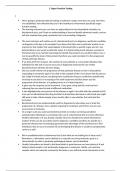
-
clinical sciences BM5CLS
- Package deal • 20 items • 2024
-
- £11.39
- + learn more
in depth lecture material created using synchronous and asynchronous clinical science lectures which are re-used on a yearly bases! this module includes sub-sections of: intro to clinical sciences, haematology and transfusion science, medical biochemand cellular pathology. 21 lecture notes. buy this package to get a headstart on youre revision!
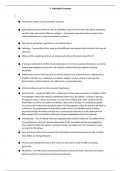
-
haemolytic anaemia
- Lecture notes • 12 pages • 2024
- Available in package deal
-
- £6.06
- + learn more
preview:● We have extravascular and intravascular haemolysis. ● Extravascular – maybe the RBCs have a deformity in their shape and what can happen is that macrophages within the reticular endothelial system (e.g. the spleen), as blood is passing through the spleen, realise that those red cells aren’t looking quite right, so they will take those RBCs out of the circulation and break it down into a number of constituents (globin into amin acids, release the iron from within the haemoglobi...
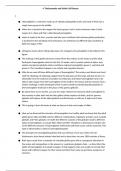
-
thalassemia and sickle cell disease
- Lecture notes • 12 pages • 2024
- Available in package deal
-
- £5.76
- + learn more
preview:● Haemoglobin is a tetramer made up of 4 globin polypeptide chains and each of them has a single haem group in the middle. ● When iron is bound to the oxygen the haem group is red in colour however when it lacks oxygen it is a blue and that's called deoxyhaemoglobin. ● Haem is made in the liver, muscles and also your red blood cells whereas globin production is localised to the red blood cell and humans can synthesise six different types of globin at different stages of life.
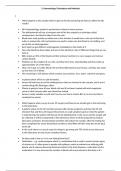
-
haematology techniques and methods
- Lecture notes • 11 pages • 2024
- Available in package deal
-
- £5.56
- + learn more
• All of haematology analysis is performed on blood or bone marrow. • The phlebotomist will use a torniquet and will do the sample by a technique called venepuncture, the blood is taken from the vein. • Blood clots really quickly so within two to five minutes it would form a clot and a fluid so in order to analyse the cells and proteins we need to make sure that blood is not clotting, and we do this via anticoagulants. • Each tube has got different anticoagulant embedded on the inside...
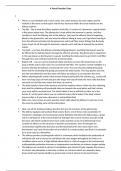
-
renal function test
- Lecture notes • 10 pages • 2024
- Available in package deal
-
- £5.56
- + learn more
preview summary:• There's a renal medulla and a renal cortex, the cortex tends to be outer region and the medulla is the more central region and the key structure within the renal medulla are the kidney nephron. • Top left – this is what the kidney nephron looks like, it consists of a bowman's capsule which is this green region here. The glomerulus is kept within the bowman's capsule, and they combine to form the filtering unit of the kidneys. You have the afferent arterial supplying b...
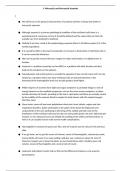
-
microcytic and macrocytic anaemia
- Lecture notes • 10 pages • 2024
- Available in package deal
-
- £5.56
- + learn more
● We will focus on the general characteristics of anaemia and then I will go into detail on microcytic anaemia. ● Although anaemia is a primary pathological condition of the red blood cells there is a surprising lack of consensus on how it should be defined and the values that you find will actually vary from textbook to textbook. ● Globally if we have a look at the epidemiology anaemia affects 1.62 billion people (1/4 of the worlds population). ● It is caused by either a decrease i...

-
organ function testing
- Lecture notes • 9 pages • 2024
- Available in package deal
-
- £5.56
- + learn more
• We're going to predominantly be looking at reference ranges, how they are used, how they are established, how effective they are in the healthcare environment specifically organ function testing. • The learning outcomes are, you have an appreciation for how biomedical scientists use biochemical tests, you’ll have an understanding of how we identify abnormal results, and we will also evaluate how good a particular test is at providing a diagnosis.
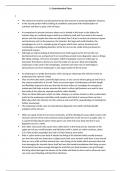
-
gastrointestinal tests
- Lecture notes • 9 pages • 2024
- Available in package deal
-
- £6.36
- + learn more
preview:• The endocrine function is producing hormones but exocrine is producing digestive enzymes. • In the second portion will be looking at conditions associated with malabsorption of nutrients and there's quite a few of these. • In comparison to previous lectures where we've looked at the heart or the kidney for instance they are confined organs which are relatively small and if you look at the overall picture not that complex but when we talk about the GI tract it consists of nu...
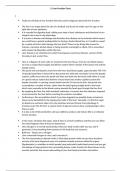
-
liver function test
- Lecture notes • 8 pages • 2024
- Available in package deal
-
- £5.56
- + learn more
• The liver is an organ about the size of a football, and it just sits under your rib cage on the right side of your abdomen. • It is essential for digesting food, ridding your body of toxic substances and therefore has an integral role in day-to-day physiology. • It is prone to disease and damage and therefore liver disease can be inherited which means you could have a genetic predisposition to having a dysfunctional liver or it could be caused by a variety of factors that damage the li...
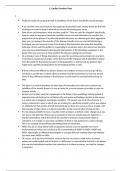
-
cardiac function testing
- Lecture notes • 8 pages • 2024
- Available in package deal
-
- £5.56
- + learn more
• If we consider how you'd want to best approach a potential exam answer these are the kind of things you want to keep in mind when you are structuring your essay. • Why do we use biomarkers, what are they used for? They are used for diagnosis specifically they are used to manage a particular condition so you can use biomarkers to monitor the progression of the disease if a particular protein increases as a disease gets more aggressive, then you can measure the severity of the disease. Eq...

£5.50 for your revision notes multiplied by 100 fellow students... Do the math: that's a lot of money! Don't be a thief of your own wallet and start uploading yours now. Discover all about earning on Stuvia


